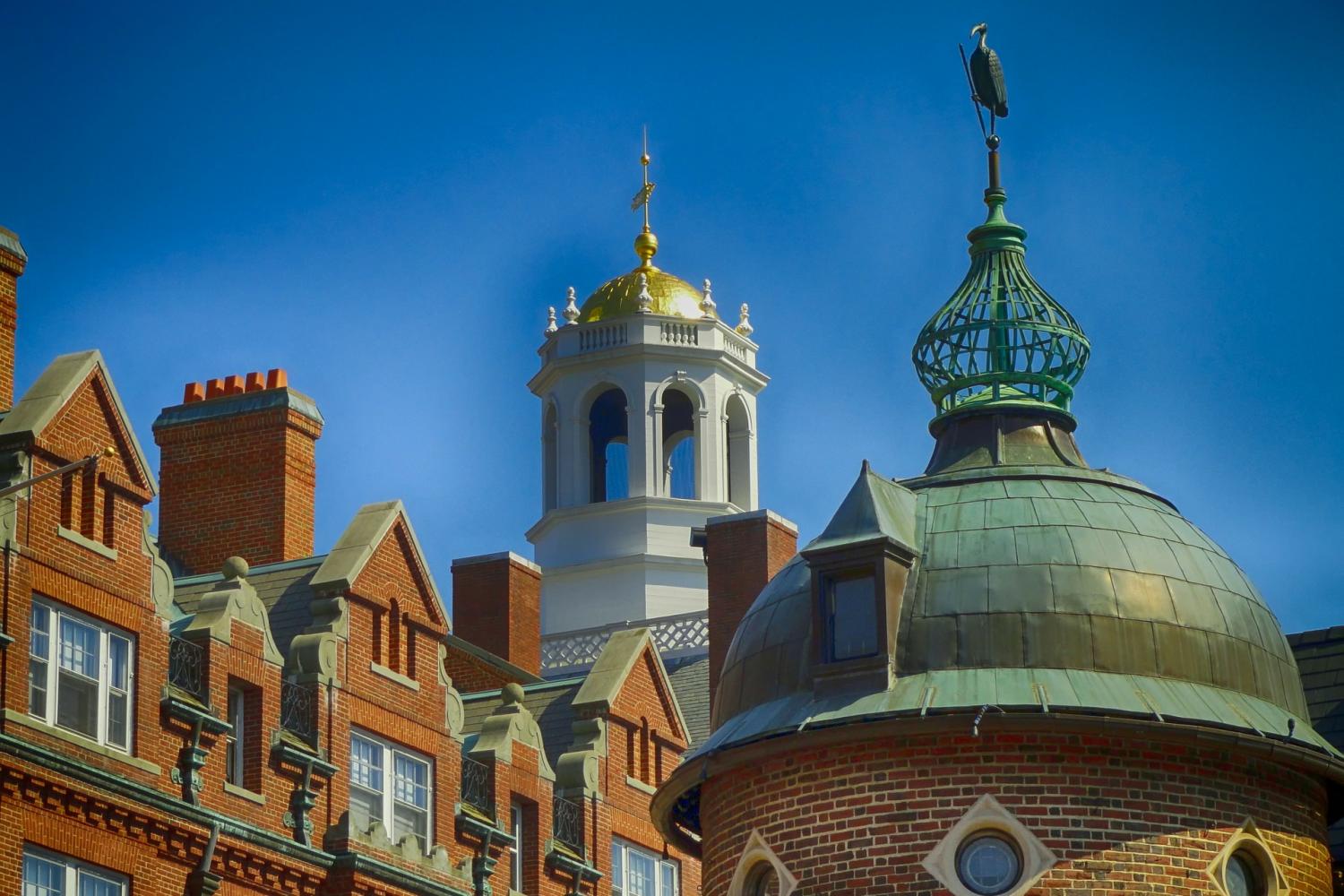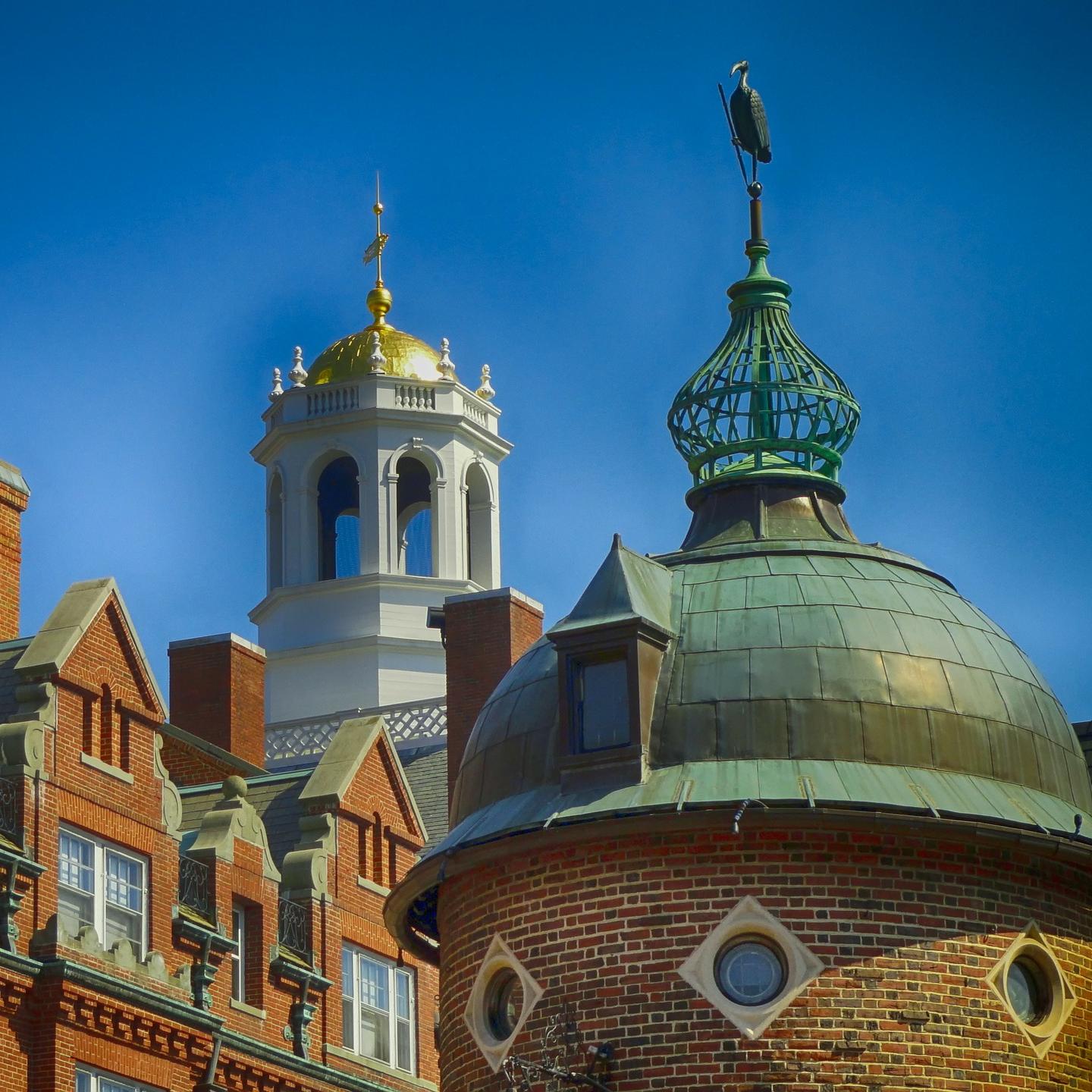We Are Trustees of Our Democracy: We Need to Act Like It


Co-written with Mackinzee Macho, a program manager in the Regenerative Justice Cities and Regenerative Design Programs at the Foresight Lab. Macho has delivered podcasts and written essays highlighting her program areas and plans on teaching courses and convening dialogues on these topics as well. She is a candidate for the Bachelor of Arts in Environmental Science at Carthage College. She is currently considering the pursuit of graduate studies in International Diplomacy.
We all have places that we go to find ourselves. Wild places, our old neighborhoods, our favorite sitting and thinking spots. These places help us to become human again when the rush and frenzy (and these days, the uncertainty and fear) of daily life threaten to dehumanize us.
In our work as corporate or nonprofit professionals, we also have such places. The garage where our business was launched. The retreat center where we determined the heart of our business was in social or cultural entrepreneurship. These places, the Lincoln Memorial, the U.S. Capitol building, municipal parks, sports stadiums, places of worship. These are places we go with our loved ones and friends, business colleagues and children, to find our shared selves, and to remember our better impulses.
One such place is the Edmund Pettus bridge in Dallas County, Selma, Alabama. We have gathered there often to express our shared confusion over the gravitational changes in our society wrought by the civil rights movement. We then visited it again to celebrate the possibility that those changes could be positive.
In the wake of Rep. John Lewis’ passing, we are impelled to ask: What is the lesson of his remarkable and signal life for us as business and organizational leaders? Because of the courage of Rep. Lewis and his brothers and sisters in the civil rights movement, they ultimately compelled federal lawmakers to pass the Voting Rights Act of 1965.
Today, we find ourselves separated and tribalized by political views. This is true both at work and in our personal and citizenship lives. Instead of being connected through the humanization and profound love we find in our places of resort, we are driven apart by our shallow politics, fed by media — what we used to call journalism.
Many of today's news sources serve only to confirm the biases of their viewers instead of challenging them. In concert with our seeking refuge in distraction and amusement, we do not counteract this tribalism but instead stew in it.
Just as we are trustees of our land for future generations, we are trustees of our public discourse. And just as we are trustees of our businesses for the sake of our stakeholders (in a cultural or social enterprise, of course, these include the community and ecology, as well as investors), we are called at this time to heal the divides we experience in these parts of our lives, incited by party politics and partisanship. Patently, our politicians will not bridge this division. It is up to us.
A trustee carries an outmoded trait as her banner: fidelity. Faithfulness to principles and honor. A trustee protects and stewards that to which she is entrusted for the benefit of another. In this way, we are trustees of our public discourse, and of our democracy.
For us in business and organizational leadership positions, this trusteeship demands that we ask harder and deeper questions about everything from our brand and market positioning, to the diversity of opinions from stakeholders we engage to validate our impact goals or compliance with benefit corporation legal requirements.
And of course we must to a better job of recruiting and educating our employees and colleagues about the value of diverse viewpoints, orientations and life experiences. The social science on this point is clear: It is demonstrably true that companies and philanthropies with people of color and women on their boards perform better. This is true in terms of profit for companies and of effective impact and social change for philanthropies and nonprofits.
When we take these issues to heart, and work to run our organizations as though the watchful and gentle eyes of leaders such as Rep. Lewis were watching over our shoulders, perhaps it is then we can begin to innovate our approach to diversity and inclusion.
We gathered together as a nation again at the Edmund Pettus Bridge on July 27 to celebrate Mr. Lewis’ life. It was that of a simple and humble man who rose to prominence reminding us of civic virtues: service, honor, respect and kindness. These traits described and innervated Rep. Lewis. His words, deeds and spirit suffused our national culture for five decades. He reacted to the vicious blows of batons wielded by law enforcement officers, and words of hate hurled by his fellow citizens, with tranquility and a tangible inner light and strength. He refused to return those physical and emotional insults.
He exemplified the principle of trusteeship of our democracy. Today, as we go to our places of business, worship, communion and play, perhaps we can all consider what we can do to embody service, honor, respect and kindness.
In trusteeship and service to each other, we can make our schools and playgrounds safe and sensible spaces of protection and learning for our children. In honor, we can work to eliminate the current coarsened and polarized tenor of our civic debate. In respect, we can find ways to make our business and work lives more humane. And in kindness, we can begin the essential work of healing our centuries-long struggle to become an inclusive and truly representative society.
The wellspring of all these traits so effortlessly embodied by Mr. Lewis is, of course, love. Too often, we misunderstand this simple emotion. As quoted by Adam Kahane in Power & Love, Bill O’Brien (the past president of Hanover Insurance), spoke thus: “By ‘love,’ I mean a predisposition toward helping another person to become complete: to develop to their full potential. Love is not something that suddenly strikes us - it is an act of the will. By “an act of will,” I mean that you do not have to like someone to love him or her. Love is an intentional disposition toward another person.”
Let us consider this expression of love as the source of the wisdom, patience, and courage we will need in the coming weeks to approach our next election as trustees of the gift of democracy, as the heat and turmoil of our summer turns to the cooling, multi-colored tapestry of autumn.
"You are a light. You are the light. Never let anyone — any person or any force — dampen, dim or diminish your light … Release the need to hate, to harbor division, and the enticement of revenge. Release all bitterness. Hold only love, only peace in your heart, knowing that the battle of good to overcome evil is already won." ― Rep. John Lewis, (D. GA) quoted in Across That Bridge: A Vision for Change and the Future of America
Image credit: David Mark/Pixabay
Levi’s Sets A High Bar for Getting Out the Vote, But the Hard Work Has Only Just Begun


U.S. businesses have been slow to react to the Postal Service crisis, but many have been gearing up to ensure that voters are educated about voting and motivated to vote in the November 3 election. That could make a crucial difference in turnout as the Trump administration continues to foster doubt and confusion over the security of mail-in ballots in particular, and the elections process in general. Levi's, however, has a plan to help blunt any such disruptions.
Levi’s hits the gas on voter education
In the latest development, Levi’s recently launched a public information campaign to encourage voter participation.
Levi’s took the issue of voter confusion head on. The company’s “Unzipped” blog editor Danielle Samaniego opened the campaign on August 20 with a direct challenge to voters.
“Election Day will not go perfectly. You may be discouraged. Obstacles will abound,” she wrote. "Vote anyway.”
For the new campaign, Levi’s tapped model and activist Hailey Bieber and filmmaker Oge Egbuonu to deliver a striking public service announcement on YouTube in an effort to reach 70 million young eligible voters. Artist Jazmine Williams and photographer Djeneba Aduayom also collaborated on the project.
The PSA does not simply focus on who will become president. It emphasizes state and local elections, including sheriffs, district attorneys and thousands of other elected offices that directly impact the lives of individuals. It is a message about control over destiny.
The PSA also goes beyond exhorting individuals to vote. It further encourages young people - and all people - to talk and write about voting.
“[Bieber and Oge] called on activists, scholars, organizers and their friends to help them deliver a powerful message rooted in education and emotion,” wrote Samaniego.
The campaign also recognizes that there is a gap between having conversations and actually going through the process of voting. Talking, writing and thinking about key issues are all part of a first step that leads to voting.
“My hope with this call to action is that it would encourage, educate and inspire this next generation to vote in November and to understand why it’s important,” Bieber explained in that Levi’s blog post.
Partnering with activists for a successful campaign
Within another part of the campaign, Levi’s has tapped into a network of independent activists to help motivate potential voters to take action and become actual voters. The company has recruited 23 voting rights and civic engagement organizations to participate in its ongoing #UseYourVoice LIVE social media campaign.
In addition, Levi’s says it is providing a total of $2.6 million in financial support to all 23 groups through its corporate arm and the Levi Strauss Foundation.
“These organizations are working to remove barriers and improve access to the polls, mobilize voters in marginalized communities and engage young voters in the democratic process,” wrote Samaniego in the Unzipped blog. “Each community partner supported through this portfolio is leading high-touch, high-impact engagement efforts with communities that are too often left out of the democratic process. Together they seek to educate, empower and activate millions of voters across the nation.”
The bottom line on voting rights
In today’s business environment, consumers are receptive to messages about social justice. Practically any leading company has an opportunity to build brand reputation by promoting voter education, voter rights and voter participation.
Levi’s has taken the bottom line factor a step farther, by linking its PSA and social media campaigns to a line of get-out-the-vote T-shirts, sweatshirts and tote bags.
Some of the items simply read, “Vote.” Others highlight the two-stage motivational strategy behind the PSA with the messages, “Don’t just post about it. Vote about it.”
Similarly, other messages exhort consumers to go beyond dreaming and thinking, to voting.
It seems that Levi’s has thrown down the gauntlet. It will be interesting to see if other brands take up the challenge and begin marketing voter participation under their own banner.
What’s to hate about get-out-the-vote?
Levi’s is aiming to stake out ground as the brand leader on voter participation, but it is far from the only company to get involved during this election cycle.
In the weeks leading up to November 3, it is possible that some of these other companies may take a page out of the Levi’s book, and step up their activities.
One example is the organization Business for America, which mustered 400 companies as part of a successful get-out-the-vote campaign during the 2018 election cycle. BFA has upped the ante with a goal of 1,000 participants for 2020.
This year, the participants include Levi’s, Patagonia and many other familiar names in the social justice arena - but also participating are Best Buy, Walmart, PayPal and other nationally recognized companies that touch tens of millions of consumers.
In addition, businesses are finally beginning to respond to widespread reports of delays in mail delivery following the appointment of Louis DeJoy as Postmaster General. The American Sustainable Business Council, for example, has rounded up its network of more than 200,000 members in support of the U.S. Postal Service.
DeJoy’s recent testimony before the House and Senate highlighted apparent conflicts of interest and an irregular appointment process, lending force to ASBC’s arguments for restoring the Postal Service to normal operations.
“The USPS provides every American address with the same equal service with equitable pricing,” ASBC wrote in an open petition.
That argument for address equality is directly relevant to voter participation during the COVID-19 outbreak, as elections planners in many states turn to mail-in ballots as a means of preventing the spread of the virus.
Meanwhile, the president has presented the public with messages that raise doubts about the security of the mail-in process, the use of standalone drop boxes, and personal safety at polling locations. Voting advocates are concerned that these messages will dampen voter turnout before November 3, and possibly lead to litigation and civil unrest in the days afterwards as millions of mailed-in ballots remain to be counted.
Companies that support voting rights in 2020 election cycle may find that their work has only just begun. They should start preparing now for a continued effort that lasts long after the polls close on November 3.
Sign up for the weekly Brands Taking Stands newsletter, which arrives in your inbox every Wednesday.
Image credit: Kari Sullivan/Unsplash
Harvard University Sends a Message to the Fossil Fuels Sector


In life, real or imagined, we’ve long learned that the best job is often accomplished within, rather than by pressure from the outside. Whether it’s in politics or the private sector, the fastest way to enact change is to have a seat at the table, as advocates of racial equity and diversity often remind us. We’ve seen this come to fruition at Harvard University.
Elections for the Board of Overseers at Harvard are usually quiet and staid affairs. And why shouldn’t that be the case, as the university boasts an endowment close to $41 billion in value? Compared to many private universities, Harvard is in an enviable financial position.
But a group of alumni took bold action over the past several months as it presented a slate of candidates for director roles. And this year, alums weren’t messing around. The big story is that five of the six of newly elected members on this 30-seat board are people of color, but the results also send a pointed message to the fossil fuel industry.
The group that banded together calls itself Harvard Forward. Launched last fall, it emerged on the scene with a letter urging the university to step up on climate action by divesting from fossil fuels.
“At a time when bold action and leadership are required, Harvard is falling behind in its response because our governance is not representative of our alumni and student bodies,” Harvard Forward said in a letter. “Our forward-looking platform calls for divesting from fossil fuels, bolstering our responsible investment practices, and increasing support for climate-related research and education initiatives.”
The letter’s tone was also prescient for inferring that the university’s Board of Overseers wasn’t necessarily representative of the student body and alumni. In its argument for wider change, the letter added, “The University will be more attuned to contemporary issues on campus, and students and alumni 30 years from now won’t have to organize around petition tickets again to nudge Harvard onto the right side of history.”
Divestment from fossil fuels has accelerated in recent years, as various organizations including churches, pension funds and companies have decided such risks outweigh any potential gains. Many universities still hold fossil fuel-based equities within their portfolio, however. Yet the dominos are starting to fall. The University of California system announced its complete divestment from fossil fuels earlier this year. Adding Harvard University to the list gives this movement even more street cred.
More importantly, the changes occurring within the Harvard board shows that when pushing for environmental sustainability, social justice or any cause for that matter, the best way to transform an organization is by becoming one, or several, of the decision makers.
Protests only get you so far. We’re witnessing such challenges now with the Black Lives Matter movement, which has inspired people of all backgrounds. Nevertheless, municipal, statewide and federal leaders — not to mention business leaders — have still been slow to act. Yet change is underway, from Missouri to New York City, as this fall’s likely election of several people of color to Congress will help push the movement forward.
The same goes for the Ivy League, where a protest against fossil fuel investments disrupted the annual Harvard-Yale football game last November. That tactic scored many headlines, but barely moved the needle.
If a coalition like that of Harvard Forward can score wins at one of the stodgiest tradition-bound universities in the U.S., it can happen within corporate boards as well. And that should keep energy company executives awake at night as this pandemic has shown it could actually accelerate further divestment, rather than stalling it.
Sign up for the weekly Brands Taking Stands newsletter, which arrives in your inbox every Wednesday.
Image credit: David Mark/Pixabay
Outlook for Petrochemicals Darkens as Plastics Pact Launches U.S. Chapter


Several years ago, stakeholders in the fossil fuels sector began a hard pivot toward petrochemicals as a hedge against the growing threat of renewable energy. Now it looks like that door is slamming shut as well. A multinational circular economy effort called the Global Plastics Pact has just kicked off a U.S. chapter with the aim of fostering innovations that will all but certainly reduce the need for fossil-based plastics and other petrochemicals.
Shell and BP read the circular economy tea leaves; ExxonMobil didn’t
ExxonMobil, Shell, and BP illustrate contrasting approaches to the rise of the circular economy.
Here in the U.S., ExxonMobil doubled down on its fossil fuels portfolio throughout the shale gas boom, including a major expansion of its petrochemical plant in Bayway, Texas.
Meanwhile, the company’s activity in the area of renewable resources has been negligible, with the exception of a commitment to foundational research in the field of algae biofuel.
That turned out to be a bad decision. The COVID-19 crisis exposed cracks in ExxonMobil’s business model, and yesterday the company was booted from the Dow Jones Industrial Average.
In contrast, Shell has taken a more diversified approach, highlighted by significant investments in wind energy, solar technologies and vehicle electrification.
BP has taken the diversification pathway to a whole new level. In addition to investments in renewable energy, green hydrogen and other clean technologies, earlier this year the company sold all but one of its petrochemical facilities. More recently, BP announced an ambitious plan to cut back on its oil and gas operations.
Enter the U.S. Plastics Pact
The circular economy has been slow to materialize. However, companies like Shell and BP appear to recognize that the movement is gathering steam. They are positioning themselves to become participants - and not a moment too soon. The U.S. Plastics Pact is a collaborative effort led by The Recycling Partnership and World Wildlife Fund, and it will become part of the Ellen MacArthur Foundation’s Global Plastic Pact network.
“The U.S. Plastics Pact is an ambitious initiative to unify diverse public-private stakeholders across the plastics value chain to rethink the way we design, use, and reuse plastics, to create a path toward a circular economy for plastic in the United States,” The Recycling Partnership explained in a press release announcing the new partnership.
The U.S. Plastics Pact has set high-impact goals that would be difficult if not impossible for companies to achieve on their own.
For example, the organization pledges that problematic and unnecessary packaging will be defined by 2021 and eliminated by 2025.
The remaining plastic packaging will be 100 percent reusable, recyclable, or compostable by 2025. Within that goal, the Plastics Pact expects 50 percent of plastic packaging to be recycled or composed by 2025.
Private sector partners have not been announced as of this writing, but a glance at the Ellen MacArthur Foundation’s 850-member global circular economy network hints that the impact will be a powerful one.
The list of participating companies in the circular economy network includes many iconic U.S. brands, including 3M, BASF, Cargill and DuPont.
The participation of U.S. companies in the effort is important, because the Global Plastics Pact says it can tailor solutions for countries and regions.
“The U.S. Plastics Pact brings together plastic packaging producers, brands, retailers, recyclers, waste management companies, policymakers, and other stakeholders to work collectively toward scalable solutions tailored to the unique needs and challenges within the U.S landscape, through vital knowledge sharing and coordinated action,” the Plastics Pact explained.
A sea change for the plastics and petrochemicals problem
Now that the ocean plastic crisis is firmly embedded in the public eye, companies have a strong bottom line motivation to rethink petrochemicals and push the circular economy into high gear.
Some recent developments in services and technology are already providing an assist.
The interest in reusable containers recently got a boost from the startup Loop, which has enlisted a growing number of leading household brands in a returnable container service reminiscent of old-time milk bottle delivery. Loop has partnered with UPS to drop off and pick up the containers.
New recycling technology will also play a part. In contrast to simple shredding or melting, researchers are developing next-generation methods for breaking down paper, plastic and other materials into molecular elements that can be reconfigured into new high quality products.
The rise of bio-based materials in the supply chain will also help the Plastic Pact meet its goals. Coca-Cola and Ford are among the U.S. companies pushing their supply chains in the direction of renewable resources.
The Plastic Pact 2025 goal is less than five years away, but with a strong collaborative effort - and support from consumers - there is a strong possibility that companies participating in the effort will meet that goal.
As for other companies still focused on petrochemicals and plastics, they could find themselves left behind. Now would be a good time for ExxonMobil to take its algae research out of the lab and into the streets.
Image credit: Zbynek Burival/Unsplash
More U.S. Business Leaders Finally Speak Up for the USPS


With reports of U.S. Postal Service (USPS) disruptions reaching a fever pitch, business leaders are finally beginning to speak out and demand a return to normal operations. So far, the only organized group to step up is the nonprofit advocacy organization American Sustainable Business Council (ASBC), but in the long run this group could wield considerable influence through its member network of more than 200,000 businesses.
Business speaks up for business
The ASBC member list is currently dominated by mid-sized and smaller companies in the areas of sustainable consumer products and renewable energy, yet these businesses’ influence over public policy reflects growing public support for sustainable policies. Among the top level “Platinum” members are well known brands including Patagonia and Ben & Jerry's.
Late week, the ASBC began to rally its members in support of the USPS after multiple reports surfaced newly appointed Postmaster General Louis DeJoy has taken steps resulting in substantial delays in mail delivery.
The firestorm of attention forced the U.S. Senate to hold a hearing on August 21, during which DeJoy testified about his actions. He also appeared in front of a House committee yesterday, during which he pushed back hard against accusations that the changes he was overseeing were a plan to sabotage the USPS.
Much of the attention has involved the impact of DeJoy’s reported actions on mail delivery for the November 3 elections. As a protective measure against COVID-19 infection, many more voters than usual are expected to use mail-in ballots.
However, that is not the only impact. DeJoy’s reported actions have also put small businesses at risk.
In the run up to last week’s Senate hearing, ASBC drew attention to the issues at hand by issuing an open letter to the Senate Homeland Security and Governmental Affairs Committee.
While noting the potential impact on the November 3 elections, the ASBC letter also points out that the USPS provides a level playing ground for countless small businesses.
The USPS provides “a crucial service to all businesses, ensuring access to fair pricing through all geographic regions in the United States for its courier service,” ASBC explains.
ASBC also notes the disproportionate impact of delivery delays on rural communities.
“As businesses and customers rely heavily on USPS mail service, most especially in ‘last-mile’ service in more rural areas, the ASBC seeks assurance that whichever operational decisions were made that affected service be halted permanently,” the letter urges.
ASBC makes the case for the USPS
ASBC followed up last week by exhorting its members to sign a petition calling for DeJoy’s actions to be rolled back, and for the USPS to receive full funding.
The petition highlights the impacts on U.S. businesses in the context of the global economy.
“Nearly half the entire planet’s mail flows through the United States Postal Service. Both as a domestic and global courier service, the post office is an impressive and necessary institution and provides a critical service for businesses around the world,” the petition notes.
“The USPS delivers to 160 million residential and business addresses six days a week, with an inclusive pricing model designed to meet the needs of all kinds of business budgets,” it continues, adding that for-profit services through FedEx and UPS are “simply cost prohibitive for many small businesses.”
“The USPS provides every American address with the same equal service with equitable pricing,” the petition emphasizes.
That goes for large companies as well as small businesses. As the petition notes, FedEx piggybacks its deliveries on the postal service’s trucks. Amazon entered into a “last mile” contract with USPS earlier this year, and UPS entered into a similar agreement with the Postal Service that dates back to 2012.
Not incidentally, DeJoy’s stock option holdings in Amazon have also come under scrutiny, in addition to other financial entanglements.
Crickets from socially responsible corporations
If any three leading corporations are in position to speak up for USPS, they are FedEx, UPS and Amazon.
All three have all been working overtime on their corporate social responsibility profiles on a wide range of issues.
In June, Amazon announced a new $2 billion climate fund. The move followed considerable negative media attention after employee climate activists took aim at the company.
UPS has been focusing on the circular economy for a number of years, partly through a partnership with a zero waste company called Loop. That partnership networks UPS with sustainable brands like Seventh Generation, in addition to legacy brands like Tropicana and Clorox among many others.
UPS is also investing in zero emission technology, as is FedEx.
FedEx was an early adopter of electric trucks, with demonstration projects dating back to 2011. In 2018 the company began stepping up its fleet electrification efforts with bulk orders for vehicles and charging stations.
As for social issues, in 2017 UPS announced “the largest CEO-driven business commitment to advance diversity and inclusion within the workplace.”
Amazon touts its support for 10 employee-lead affinity groups covering 40,000 employees, and FedEx makes a point of the bottom line benefits in its diversity and inclusion statement.
Considering their reliance on the USPS and the disproportionate impacts on small businesses and consumers — including veterans who rely on the post office to deliver their medications — the allegations against DeJoy should have Amazon, FedEx UPS and other companies running down the halls of public discourse with their hair on fire.
So far only ASBC members are carrying the torch. Amazon, FedEx, and UPS — and the rest of corporate America — need to step it up and put real action behind their words.
Sign up for the weekly Brands Taking Stands newsletter, which arrives in your inbox every Wednesday.
Image credit: Lynn Wray Dillard/Pixabay
As COVID-19 Disrupts Lives Worldwide, Young Entrepreneurs Are Stepping Up


Though young adults have a higher recovery rate from COVID-19 than other age groups, the pandemic's impact on global youth’s socioeconomic success is here to stay. But new innovations and the pivoting of operations are not just a corporate response; youth are also responding to this crisis with significant contributions.
COVID-19 is wreaking havoc on young citizens’ futures
Right now, more than 90 percent of students worldwide are experiencing loss of in-class learning as a repercussion of the virus. Lost and prolonged months of education affects income earnings, the readiness to enter the workforce or bounce back up from layoffs and school dropout rates.
As youth tend to have less in savings and own fewer investments, financial hardships are harder to overcome. U.S. students from grade K-12 are estimated to lose $61,000 to $82,000 in their lifetime earnings as a result of COVID-19 school closures. This loss only widens the existing growing socio economic gap between white versus Black and Hispanic students in the U.S.
Not only will younger generations experience financial loss, but competing with experienced professionals in competitive fields will be disheartening. At first glance, these statistics may seem daunting to overcome, but agile corporate and organizational action can arm youth to face these challenges. And they already are.
Young entrepreneurs are building opportunities worldwide during the pandemic
In March, 24-year-old Jorge Richardson founded a search engine, TogetherCard, to support local businesses and entrepreneurs. Through this U.S. based platform, users can support local businesses by purchasing gift cards. Entrepreneurship is one answer for some youth, pivoting is another. Digital platform SEPAK sells Cambodian-produced products for ethical prices and in response to COVID-19, production was pivoted towards creating handmade masks. SEPAK donates one mask to a local charity when a customer purchase 10. Similarly, the founder of Gaber Garment, Jennet Lemma, responded to COVID-19 by pivoting operations of her garment manufacturing social enterprise to manufacture masks and distribute them locally.
These entrepreneurs prove that plenty of youth are acting with the future in mind. But in the current atmosphere where budgets are tight, and layoffs are likely, long-term strategies are needed to deal with this economic turbulence. Investing in youth-focused education, mental health and customer relations builds a foundation for young adults to contribute to society continuously and drive action.
Young leaders are inspiring action worldwide
During this month, International Youth Day, United Nations Educational Scientific and Cultural Organization (UNESCO)'s "My COVID-19 Story" campaign highlighted how youth are tackling social, mental and financial challenges by starting YouTube cooking channels, live streaming performances, creating and delivering personal protection equipment, and helping deliver groceries to elders.
These young adults are filling learning gaps through tools for which they are best known. In 2015, Divya Gokulnath, the co-founder of the educational technology platform, Byju’s, was ahead in the digital arena by investing in online educational technology. After exceeding demand for his service, Raveendran expanded Byju’s with a subscription-based service that provides school curriculum through video. Shortly after COVID-19, Byju’s was available to students at no cost, which in return boosted users and subscription rates.
They may not be an immediate win-win for some businesses, but quick and cognizant responses and investments towards tackling long-term problems are inevitably beneficial. Entering the workforce is competitive now, so to tackle gaps in skills and prevent job losses, David Blake launched Learn In to work with employers to train their employees to obtain skills needed for the future as opposed to replacing or laying them off.
Large corporations are acting, too. For example, Target is investing in its employees through increasing wages, childcare and paid leave; American Express has said it is refraining from COVID-19 related layoffs as it pays salaries and provides coverage to employees affected by the virus, and Home Depot has provided its associates with additional paid time off.
Such engagement helps young professionals and students, especially those living in low-income households or with disabilities participate and create innovative resources to tackle COVID-19 and its prevention itself. Disadvantaged younger generations in rural or developing countries face problems of access to educational technologies such as the Internet, stable employment and personalized learning.
To that end, CEO and founder Timothy Yu, who founded the on-demand education app Snapask, saw an opportunity to bridge this gap. During COVID-19 closures, Yu collaborated with Singapore officials to provide free learning services and news to students. Through various technology packages, students have access to elementary and college level resources and tutors.
Corporate investment and youth engagement in education, employee well-being and public health are the building blocks of preparing better for COVID-19’s consequences. By going back to basics and ensuring everyone is helped with access to internet, health resources and financial support; we can quickly move towards a strong economic recovery.
Image credit: Julia M Cameron/Pexels
Proposed DOL Rules Undermine Investors’ Ability to Gauge ESG Risks


Earlier this summer, the U.S. Department of Labor (DOL) proposed to change a rule that would make it very difficult for managers of retirement plans - including 401k savings and pensions - to consider non-financial factors, such as environmental, social and corporate governance (ESG) when choosing an investment. Moreover, the DOL’s suggested changes would preclude 401k plans from using an ESG or sustainable investment as a default choice in any public or private retirement plan.
This new rule will potentially affect more than $10 trillion in U.S. retirement plans and poses a massive threat to the responsible investment industry - an industry that has touched over 490 million lives with a cumulative investment of $11 billion over the last 10 years. This proposal threatens to be a substantial disservice to our country and investors alike by preventing Americans from building wealth through a means that will truly make a difference, especially during a time when we need it most.
Debunking the myth that ESG investments do not offer competitive returns
Apparently, the DOL is concerned that ESG investments increase risk and subordinate financial performance, which would go against the Employee Retirement Income Security Act (ERISA). ERISA asserts that retirement plan managers can’t sacrifice financial security for any reason.
Now, it’s important to note up front that the proposed DOL rules are based on a faulty assumption, one that says sustainable investments can’t compete with traditional investments from a financial perspective.
Recent research debunks that assumption. Investments that consider ESG factors have performed as well—and in many cases better—than investments based solely on traditional pecuniary considerations.
A white paper by the Morgan Stanley Institute for Sustainable Investing found that in examining approximately 11,000 mutual funds from 2004 to 2018 there was no financial trade-off in the returns of sustainable funds relative to traditional funds. Sustainable funds also demonstrated lower downside risk.
The business case for ESG investing
Similarly, a highly regarded 2016 study, led by George Serafeim of Harvard Business School, found that stocks of companies with the strongest performance on ESG issues outpaced those with relatively poor performance.
Sustainability is a major risk factor for corporations today. As such, they are understandably placing greater emphasis on ESG risk analysis and performance. Most CEOs and company directors now realize that sustainability issues are strongly associated with financial performance. They understand that more and more consumers—especially younger consumers—are demanding that the companies they do business with perform well on ESG criteria.
A study published in 2015 by the University of Oxford and Arabesque analyzed approximately 200 scientific studies on the economic impact of sustainability and found that strong ESG performance was positively correlated with better stock price performance (80 percent of studies), better operational performance (88 percent of studies), and lower cost of capital (90 percent of studies).
It turns out that “doing good” is also good business.
Barring ESG investments can hurt future generations
Given findings such as these, it can certainly be argued that retirement plan managers that don’t consider ESG factors when evaluating the potential financial performance of investments are not fulfilling their fiduciary responsibilities. In fact, if two investment options have the same or similar performance, ESG vs. non-ESG, the investment manager should indeed weigh ESG more heavily since there is a positive societal impact not reflected in non-ESG performance. In effect, in choosing more responsible investments, everybody wins.
This is especially important to younger investors participating in 401k plans and other retirement accounts who are spearheading the shift to “conscious investing.” In fact, a 2019 study by Morgan Stanley found 95 percent of Millennials are interested in focusing on sustainable investing. Curtailing sustainable investing can negatively impact this core component of the larger movement toward a more conscious and inclusive capitalism by limiting opportunities for these individuals to build wealth through a means they can feel good about—particularly in the long-term.
ESG investments should always be an option
The emphasis on traditional financial analysis when evaluating potential investments is flawed in its singular focus. If retirement plan managers and investors rely on historic financial trends, sans environmental, social and corporate governance impact, it’s likely that excellent financial investments will be missed due to an ESG blind spot.
Implementing the proposed DOL rules would unnecessarily hamstring retirement plan managers from performing comprehensive analyses of investment opportunities. As such, implementing these rules would be a major disservice to both retirement plan managers and investors.
The bottom line is, companies that utilize ESG criteria in their management practices are typically well-managed companies and as a result consistently have better financial performance. And retirement planners who include sustainability factors in their investment analysis are the new gold standard.
Image credit: Alexander Schimmeck/Unsplash
Can Job Training Close the ‘Opportunity Divide’ Post-Pandemic?


Roughly one in five U.S. workers are collecting unemployment benefits, and as coronavirus case numbers surge across the country, job prospects seem slim for many. Even before the pandemic, nearly 28 million Americans were unemployed or underemployed due to a lack of relevant job training, a lack of education, or simply a lack of access to pipelines for better paying and more stable positions.
Would-be workers aren’t the only ones who lose out when talent is left on the table. Entire communities are affected when residents struggle to find gainful employment, and businesses face unavoidable long-term risk if workers are not equipped with the right skills to fill vacant positions once employment levels return to normal.
Investing in job training offers long-term benefits for communities and employers
Investment in job training within historically underserved communities is a key lever companies can use to bolster their own pipelines while bettering the communities they serve. As the coronavirus pandemic continues to disrupt the U.S. workforce and renewed conversations around racial equity highlight the disparities within it, business now has an even greater opportunity to rethink how it perceives — and invests in — future talent, Aleta Stampley, director of community impact and investing for Capital One, told TriplePundit.
"We are in the midst of a real movement. We have a chance to be better if we take it. Both COVID-19 and the murder of Mr. Floyd have once again revealed societal injustices and inequalities," Stampley said. "Disproportionately the folks who have been boxed out of the workforce and small business spaces have been persons of color, which is why we need light, illumination and innovation to bring greater access.”
Stampley and her team at Capital One support job training in underserved communities across the U.S. with $50 million in annual funding across over 200 community-based organizations, including those that support workforce development. In June, the company pledged an additional $10 million to organizations advancing social justice in Black communities and established a dollar-for-dollar gift-matching program for employees looking to support the cause. Given what we know about racial equity in the workforce, particularly in the midst of severe economic disruptions, the company’s focus on diversity, inclusion and belonging efforts with workforce partners is needed now more than ever.
What we know about racial equity in the workforce — and what is needed for change
The fallout from the coronavirus pandemic is devastating for everyone, but history tells us that communities of color bear the heaviest burden of significant economic downturns. Overall unemployment peaked at 10 percent during the Great Recession of 2008 and 2009, but jobless rates trended higher — and lasted longer — in communities of color: 16.8 percent of Black workers, 15.1 percent of Native American and Alaska Native workers, and 13 percent of Hispanic workers were unemployed at the peak of the recession. Unemployment rates for these groups did not return to pre-recession levels until 2017. During this time, Black and Hispanic households lost 48 percent and 36 percent of their respective wealth.
Early research shows a similar pattern as a result of the coronavirus: The unemployment rate for Black workers neared 17 percent in June, compared to around 14 percent for white workers.
These disturbing trends beg a number of questions: Why are Black, indigenous and people of color more likely to earn less money, retain less wealth, and work in less stable positions? And why are they more likely to lose their jobs when crises strike?
Workers need more access to opportunity
Lack of job training is just one reason people struggle to find work or advance in their careers. Access to opportunity is another crucial piece of the puzzle, and committing to remove systemic barriers is the best way to ensure the success of any workforce program or job training efforts.
Capital One is focused on four key areas when it comes to improving racial equity in the workforce.
- Narrative change. Changing the narrative "is about ensuring ‘truth in storytelling’ and removing stereotypes and inaccurate language from the narratives shared about racial groups,” Stampley said.
- Systems change. “Systemic inequalities disproportionately affect persons of color, particularly Black people,” she explained.
- Power. Essentially, this is about “having and influencing seats at a table — and not just any seats, but the ones that make talent and workforce decisions,” Stampley told us.
- Asset attainment. “This is more than having a great job — it's about having a great career and network to create the opportunity to build wealth,” she said.
Targeted job training investments provide a means for change
“When you think about those four barriers, there's not a one that hasn't played a role at a grassroots level in impacting our ability to succeed,” Stampley said. “Capital One is not only working on the symptoms of systemic racism, but we’re committing to addressing it at its root cause and try to change the baseline, the systems themselves, so that we don't keep working on the same problem.”
Capital One’s work with community-based job training and workforce development organizations offer insight into how this plays out. For example in the Bronx, the company partners with The Knowledge House, a tech and career training organization staffed entirely by people of color. The nonprofit offers a 12-month fellowship designed to promote technology-based career opportunities for New York residents in fields such as web design and data science.
Fellowships focus on people with little to no formal post-secondary education or tech experience, with a preference toward residents of the Bronx and upper Manhattan. With fewer major employers located in these neighborhoods, job-seekers have limited opportunity to obtain gainful employment in their own communities. Partnering directly with major employers like Capital One helps The Knowledge House develop a pipeline for emerging fellows, and opportunities may only open further as more companies shift toward remote work due to the coronavirus, many saying they’ll do so permanently.
“As so many companies move their work — especially their technology work — remotely, now folks don't have to leave their neighborhoods,” Stampley said. “They'll earn a livable wage, if not a higher living wage than they are right now, and get a chance to work for big corporations that may or may not be located in that community. What an amazing model that will stand the test of COVID and actually become a best practice that happens in the post-COVID world.”
For The Knowledge House, partnerships with companies like Capital One help to fund capacity building and new technology to scale the program to more people, with the nonprofit having reached more than 1,700 students thus far.
“Capital One is a bank that cares about the communities where they have branches, and the Bronx is one of those communities,” said Jerelyn Rodriguez, co-founder and CEO of The Knowledge House. “To see Capital One invest in nonprofits in these neighborhoods really demonstrates their passion for the communities they serve. They want to make sure their clients have thriving neighborhoods, and they’re investing in our model so we can create jobs.”
The Knowledge House will soon extend its model beyond the Bronx: Following a successful pilot in Los Angeles last year, it’s looking to scale to Newark, New Jersey, in 2020, followed by Atlanta, thanks to financial support from its brand partners.
The bottom line
Along with technical training, Capital One also supports workforce development organizations focused on apprenticeships and internships across fields related to technology and finance, including Year Up, Per Scholas and its internal Catapult program. For Stampley, this type of investment is not only the right thing to do to better serve communities, but also a smart business decision that other major companies would be wise to employ as they look to bolster their future talent pipelines.
“In any other case inside of a company, you would pay very close attention to the pipeline of your products or services. Human capital is no different,” she said. “Philanthropy is a catalyst that knocks down the wall, but the business case says that we would be the best in the world if we could have the best talent out there. That means we have to have a broad pool to pull from.”
This article series is sponsored by Capital One and produced by the TriplePundit editorial team.
Image credit: Christina @ wocintechchat.com via Unsplash
New Arctic Drilling May Now Be Possible, But It’s Still Bad for Business


It’s official: The Arctic National Wildlife Refuge, often just called ANWR, is available for oil leasing. U.S. Secretary of Interior David L. Bernhardt signed a record of decision (ROD) last Monday that approves the Coastal Plain Oil and Gas Leasing Program, opening 1.6 million acres of the Alaska wilderness’s coastal plain to drilling. The administration could set up an auction for new Arctic drilling by the end of 2020.
More Arctic drilling is now on the table
When Congress passed the 2017 Tax Cuts and Jobs Act, it required the administration to pursue this Arctic drilling lease program, citing reasons such as protecting national energy security and supporting the Alaskan economy and job production.
In the days following the ROD, there has been backlash and threats of lawsuits. Environmental organizations including the Sierra Club, the Natural Resources Defense Council (NRDC) and Earth Justice have published statements denouncing the action to move forward with new Arctic drilling as irresponsible and reckless toward fragile ecosystems and Indigenous Peoples.
“This is an egregious intrusion into the sacred lands of the Gwich’in and other Indigenous People,” reads a statement from NRDC President Gina McCarthy. “It threatens the heart of the largest pristine wildland left in America — the birthing grounds and nursery for the Porcupine Caribou Herd, and home to polar bears, musk oxen, migratory birds and other precious wildlife.
“The administration’s reckless, relentless boosting of the oil industry will irrevocably damage this cherished place and compound the global climate crisis," she continued. "We will not let it stand.”
An odd time to invest in oil
Oil drilling activities would threaten the wellbeing of the largest wildlife refuge in the U.S., including habitats for shorebirds, polar bears and caribou — on whom the native Gwich’in rely. But drilling in the Arctic National Wildlife Refuge wouldn’t necessarily be a bust for the environment and a boom for industry. Evidence points toward oil faring poorly across this wildlife refuge.
For one, a 2017 auction for drilling on the Alaskan North Slope only sold 80,000 acres out of 10 million available. Tina Casey noted in a 2017 article on TriplePundit that if companies lack interest in established oil fields, it’s unlikely they’ll grab land where information and infrastructure are scarce and negative publicity runs high.
Oil is not on the up and up these days. With global COVID-19 quarantines keeping people at home and on the ground, oil companies are facing the lowest lows in demand. In April, oil prices fell below zero for the first time in history. There just wasn’t enough storage for the amount of oil coming out of the ground. In July, the online oil and gas rig count fell to an all-time low.
The climate action movement's opposition to big oil shows little sign of yielding
Even after the conditions of the pandemic wear off, the long-term humming of popular opinion will continue to wear away at the feasibility of the fossil fuel industry. According to last week’s statement from the Sierra Club, over the past year, five of six major U.S. banks joined more than two dozen worldwide financial institutions in excluding funds for new Arctic drilling from their lending policies.
Any company that bids for land in the Arctic National Wildlife Refuge is rowing against a powerful tide. In 2018, over 100 investors representing more than $2.5 trillion in managed assets published a letter urging banks and oil and gas companies to refuse involvement in developing the ANWR, noting the financial risk of developing fossil fuels during a global warming crisis, a reputational risk while 70 percent of American voters oppose new Arctic drilling and associated human rights and ecological impacts.
Jason Bordoff, founding director of Columbia University's Center on Global Energy Policy, summarized the situation this way in an email to CNN Business: “Even if Trump can overcome legal challenges to offer lease sales in ANWR, that doesn't mean anyone will show up given the rising social and environmental pressures, low oil prices and uncertainty about oil demand.”
At a time when even oil companies are going so far as to seek net-zero emissions, steamrolling into a pristine and fragile refuge to extract crude oil would simply be unsound business. The Trump administration may have made ANWR drilling available to any company interested, but all signs are pointing to an unsuccessful auction.
Image credit: Jared Evans/Unsplash
Solar Power as a Work-From-Home Perk? This Startup Has It Covered


Installing solar power systems is already a tedious process for homeowners, and with many of us working and learning remotely, we’re too distracted to get started. Those renting or living in states where policies have made solar power a no-go can forget about it — lower bills due to solar are a pipe dream. But as many companies scramble to keep their employees motivated and rethink perks while their employees work from home, a Washington, D.C.-based startup says it has a solution.
Arcadia describes itself as the first nationwide “digital utility” in the U.S. Since its founding in 2014, the company's platform is now available in all 50 states and with more than 100 power utilities. Users can acquire a solar power subscription from Arcadia, buy as little as one solar panel or more, and see the results as a credit on their monthly utility bills.
Therein lies an opportunity for a company’s virtual human resources desk to offer a new benefit to employees.
It’s true that we’ve seen a decrease in emissions worldwide due to the novel coronavirus pandemic; how much of a reduction varies by the sources consulted. But here’s the problem for companies: For those that are tabulating their emissions as part of their sustainability or environmental responsibility strategies, many of those emissions have simply shifted from the properties they own or lease to their employees’ individual homes. Solar power can help solve that problem.
After all, many individuals’ utility bills have bumped upward, as we’re leaving our devices charged and air conditioning units running with greater frequency — not to mention the fact we’re using our household appliances more (yes, opening that fridge door constantly as a procrastination tactic adds more to your utility bill in the long term). But with working from home becoming the reality for many through 2021, companies now have the chance to offer employees financial relief while swatting away some of their own emissions.
In a recent interview with Fast Company, Arcadia CEO Kiran Bhatraju said the company’s corporate clients so far include McDonald’s, SkySpecs and CustomerFirst Renewables. But with more companies saying that working from home for the most part ended up becoming a net positive after the initial shell shock, watch for Arcadia to win more clients as remote work is redefining the very notion of “perks.”
Image credit: Pixabay